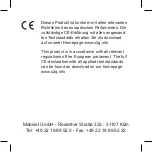
EXHAUST SYSTEM
Exhaust system components will vary from one installation to another; therefore a muffler and tailpipe
may not always be furnished with the Genset. However, it is imperative to install a muffler and tailpipe
to reduce exhaust noise and direct exhaust gases beyond the vehicles perimeter and away from the
normal head-on air stream. Install a tail pipe with as few bends as possible to prevent excessive
backpressure. A properly installed exhaust system must be vapor tight, quiet and completely safe for the
vehicle, its occupants and surroundings. Installation of an approved Spark Arrestor is required.
IMPORTANT SAFETY TIPS:
When exhaust system components are not furnished by Power Technology as part of the Genset, the
installer is responsible for meeting the following requirements.
1)
Only use exhaust system components, which do not restrict exhaust flow. A restricted exhaust
system will create excessive backpressure and may cause poor engine performance and possible
engine damage. The maximum allowable backpressure for the engine listed in this manual is
3.012in Hg, (76.5mmHg).
2)
Muffler shall be fabricated of aluminized steel or other corrosion resistant material and be of a
welded or crimp construction. A USDA Forest Service approved spark arrestor must be part of the
integral design of the muffler or provided as a separate add-on item.
3) Maintain a minimum of 3 inches (76mm) between the exhaust system components and any
surrounding combustible materials. If the minimum clearance cannot be maintained, an insulating
shield must be installed to prevent the combustible material from exceeding temperatures of 117°F
(65°C) above ambient temperature.
4) Extend the exhaust system a minimum of 1 inch (25mm) beyond the vehicles perimeter. Never
terminate the exhaust system underneath the vehicle.
5)
Terminate the exhaust system in a direction, which prevents the exhaust gases from being drawn
back into the generator compartment and re-circulated.
6)
If the exhaust system in located in an area which may become susceptible to road damage from
curbs, speed bumps, or other road obstacles a protective device such as a skid bar or plate should be
installed.
7) To prevent excessive movement and vibration of the exhaust system, install hangers and clamps
designed for use in exhaust systems.
8)
Never join or tee the generator exhaust system and the vehicle exhaust system together. Doing so
may cause excessive back pressure on the generator engine, also condensation from one engine can
damage the other engine.
WARNING:
LETHAL EXHAUST GAS! When installing the exhaust system position the tail pipe end
so that discharged exhaust gases are not drawn into the vehicle interior through windows, doors, air
conditioners, etc. During operation an engine discharges deadly carbon monoxide with its exhaust.
Carbon monoxide is particularly dangerous since it is odorless, tasteless, and non-irritating. It can cause
death if inhaled for even a short period of time. Be especially careful if operating the generator set when
parked under calm, windless conditions. Gases may accumulate in these conditions. Park your vehicle so
that the exhaust discharges downwind. Always be aware of others in your vicinity. Make sure that your
exhaust discharges away from other vehicles and buildings.
CAUTION:
Make sure the exhaust system components are positioned well away from drain openings
beneath the generator set. Also, be sure not to block access to the oil drain plug.
11






































